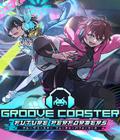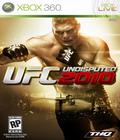Mixed martial arts hasn't always been met with enthusiasm and acceptance. Back in the early 1990s, the sport, which only existed because of the fans' appetite for more bouts after the initial pay-per-view event, was criticized for being lawless and excessively brutal. With no regulation in place and no venues in which to hold their events, the future looked grim. However, the fans remained, and after the necessary rules were in place, the venues and fighters got better, and it didn't take long before MMA, particularly the UFC, became just as accepted as boxing and pro wrestling. That same progression can also describe the games that are based on UFC. The original title on the Dreamcast was heralded as something special in fighting games, and UFC Tapout on the original Xbox was a small but worthwhile improvement to the series. Later entries languished, and soon, the series became fodder for bargain bins as soon as the new version came out. It wasn't until THQ got the license and UFC Undisputed 2009 was released that people started to take the game series seriously again. About a year after it was released, THQ and developer Yuke's have returned with UFC Undisputed 2010 with enough improvements to justify the existence of a sequel.
The game is packed with more offline modes than before, giving players plenty to do before even setting foot online. You have your standard Title mode, where you can take any of the 100 available UFC fighters through their weight classes to gain their respective championships. The ladder sizes can be varied between eight to 12 opponents, and the opponents range between randomly created fighters to actual UFC fighters. Once a title has been claimed, Title Defense mode opens; it plays out like Survival mode in any other fighting game and opens up more options for the game later on. Tournament mode is also available, where you can create a custom tournament of fighters from as few as four participants to as many as 16.
Event mode allows you to either watch or take part in actual UFC events as mirrored in real life. You can also make up your own event if you wish, with your set number of matches dictating the fight card. Each event comes complete with commentator bits, pre-match trash talk, and postgame analysis. The mode works well, and the servers are already providing downloadable UFC events, ensuring that this will get solid support for quite some time.
Ultimate Fights mode has received a big bump in presentation this year, as each of the classic bouts now has video introductions and outros, just like a UFC retrospective show on Spike TV. Having these introductions, complete with mini-interviews and backgrounds on each fighter, gives it some backing as to why it was considered important in the first place. Aside from that, the mode remains the same. Once you pick your fighter, you have a certain set of conditions that need to be met in order to open more fights and more parts of the game. For example, you might need to win via submission only, win by decision, deliver a spinning backfist in the third round, or execute seven low kicks for the entire match. Winning each match gives you montage recaps of the real fight, though PS3 owners benefit by having five more fights available to them in this mode. Considering that the rest of the game simply has you beating the stuffing out of your opponents for wins, the added variety makes the mode simultaneously frustrating and interesting.
Career mode has also seen some expansion in this sequel. The length has been expanded from seven to 12 years, though depending on your fighter's age or performance, the career can reach an early end. Unlike the first game, the career starts out in the amateurs and the WFA before you can make your way to the UFC, working your way from the undercards to the mid-cards to the main event. Fighters can now switch divisions in the middle of their careers, just like some real-life UFC fighters. Career progress now includes having to do interviews between fights once you become more popular. The biggest change the career mode has is the ability to learn from other fight styles. Unlike the first game, fighters can now learn moves from other fighting styles and incorporate them into their repertoire, regardless of their primary fighting style. The other big change this year is stat decay. All of your training will update your selected stats, but unless you constantly work on improving or maintaining them, the neglected stats begin to drop. It adds a sense of realism to the game since real fighters constantly have to maintain their own attributes. Admittedly, the long career can start to get tedious with the interviews and commentary saying the same things, but overall, the mode feels much more complete and involving than in last year's offering.
Throughout all of UFC Undisputed 2010's modes, players will notice that the fighting engine has improved a bit. Combos are no longer tied to specific button presses and are freeform instead. Just about any move can turn into a combo, making the game lean toward sport simulation rather than arcade. The takedown and submission moves are no longer tied to specific button or analog stick combos, either. Body positioning also plays a bigger part in how much damage a fighter can give or take, and while certain fighters thrive in positions where no advantage can be seen, most players will try to jockey for a better position before unleashing their moves. The result of this is a fighting system that feels a bit more technical this time around and will please those looking for more out of the game than button-mashing.
As with the Career mode, the Create A Fighter mode has also seen some improvements. There are now more parts for the player to choose from every area, including gloves, trunks and tattoos. Tattoo placement is no longer restricted to pre-determined areas, so you can place a tattoo anywhere you want, even if it was never meant to be there in the first place, and there are more options for each and every body part on the fighter. The biggest change this year is in the fighting styles and ring mannerisms. There are more base fighting styles to chose from this time around, though only created fighters who have gone through Career mode will be able to obtain moves meant for other styles of fighting. In-ring taunts and pre- and post-match celebrations can all be customized to your liking as well as fist bumps, should you choose to initiate them. The number of tweakable items is large, and while you can unlock more items through other game modes, the UFC series still has a long way to go before it matches the customization seen in Yuke's WWE franchise.
The multiplayer has seen some expansion in a few key areas, and the results are very mixed. The standard ranked and player one-on-one matches are still there and function just like the offline versus mode. Players can customize whether they want their matches to contain UFC fighters only, created fighters only, or a healthy mix of the two types. During the review period, the results for online fights varied wildly. For example, a match could run as smoothly as an offline one the first time. After a rematch has been decided, though, the next match could be plagued with severe slowdown the connection quality not dropping. Some potential online matches didn't seem to have quality connections, and using the filters to search for those with good connections resulted in little to no results most of the time. With other fighting and sports games having a large portion of their connections rank favorably in connection quality, it is disappointing to see UFC Undisputed 2010 still have a higher occurrence of issues than the competition.
New to the game this year is online Fight Camps, which function just like a guild or a clan in other game genres. Players can join or create a camp where members can enter exhibition or sparring bouts or take on the world as camp representatives. When fighting as part of your camp, your wins and losses affect the group's standing and rank. Your own rank in the camp will also impact how much you can damage or promote your camp's ranking. For example, a lower-ranked member's loss won't be as bad as a loss by a higher-ranked member, and the same applies for the wins. As the rank increases through camp milestones and overall wins, so do the logo customization options. While it may seem basic at first, the mode fulfills the clan aesthetic that most online gamers are clamoring for, and perhaps the next iteration of the game can expand on the mode some more.
One of the more controversial aspects of the multiplayer mode wasn't revealed until the week before it was released, and that is the online access code. In order to encourage people to buy the game new instead of used, there is a code in the back of the instruction manual that gives the player the ability to play the game online and use all of the modes. Without that code, players will have to pay an extra $5 to get the privilege of playing the game online and having online fight camps. While the merits or drawbacks of such a system will not be discussed here, as there are already plenty of forum posts for both sides of the argument, it is something to keep in mind if you plan on buying the game used or renting it with the intention of spending most of your time online.
Like the WWE Smackdown Vs. Raw games, Yuke's has managed to put together a control scheme that is simple yet deceptively deep. The face buttons handle foot and fist strikes, while the left trigger and bumper handle height and technique modification, respectively. The right bumper and trigger handle defense in specific areas while the right bumper, combined with flicks of the left analog stick, initiates the new sway feature. The right analog stick does almost everything else this time around, from grappling to transitions on the ground to submission initiation. It works well, as the controls are pretty responsive in all situations. Combos flow more fluidly this time around, and the game does a better job of recognizing blocks from straight hits. The same goes for the submissions, which are easier to execute than before. Both veterans and newcomers would certainly say that the control scheme has improved for the better.
The graphical upgrade between this title and its predecessor are minimal at best. That isn't to say that the graphics don't look good, but if you were to put this one side by side with the previous title, it would be difficult to spot the initial differences. This is mostly a good thing. The fighters look great and are instantly recognizable. The texture work is well done to the point where individual tattoos are very clear and legible. The environments also share this same type of texture work, and the cage has seen some improvements thanks to the sway it gives when the fighters are pressed against it. For the most part, the animation work is good. Blows are delivered smoothly, and the opponent reacts as expected, with the right amount of push depending on how strong the hit may be. Hits delivered in the clinch still look bad, especially the punches that vary from being too quick or having little to no movement at all. In a real fight, the hits in the clinch all look like they affect the opponent, but in the game, it is difficult to tell if anyone is getting hit or giving out hits.
Last year's sound was good, and this year, it's even better. The game no longer has a soundtrack filled with hardcore rock music, but the music is now more akin to a UFC pay-per-view event. There are more orchestration pieces than electric guitar riffs throughout the score, and that gives the game an epic feeling. The effects sound just as good as before, with the body impacts and falls to the mat providing a good amount of bass, and the crowd reacts correctly to each hard hit and takedown. The voice work has certainly seen some improvements this time around, including Bruce Buffer saying your full name instead of your nickname. The delivery is still top-notch, but this year, the commentators begin to remember certain fighting traits you've exhibited in Career mode. If you're a strong ground-and-pound fighter who goes to the mat early, they'll mention it later down the line. If you're weak in the clinch positions, they'll mention that as well. Like most sports games, the commentary starts to repeat after a while, but not as much as it did in the previous version. Overall, this is a very solid audio package, and while it isn't perfect, it nicely complements the game.
With the signs of UFC becoming an annual franchise, the question becomes whether each installment is worth ditching the previous game. In the case of UFC Undisputed 2010, the answer would lean toward yes, more so if you didn't purchase last year's game. The improved career modes and character creation, refind move sets and rather large roster are certainly highlights of the game's improvements. The sound has also seen some advancements, and while the graphics could use some work, it still remains impressive. Die-hard fans of UFC and of the sport will immediately have fun with UFC Undisputed 2010 while the more casual fans will enjoy the superficial upgrades.
Score: 8.0/10
More articles about UFC Undisputed 2010











 UFC Undisputed features an authentic and comprehensive UFC atmosphere, poised to deliver intelligent and intuitive combat, increased fighter customization, robust career progression, challenging new gameplay modes and explosive online offerings.
UFC Undisputed features an authentic and comprehensive UFC atmosphere, poised to deliver intelligent and intuitive combat, increased fighter customization, robust career progression, challenging new gameplay modes and explosive online offerings.



















































